The lineal descent of the People of the Five Nations shall run in the female line. Women shall be considered Progenitors of the Nation. They shall own the land and the soil. Men and women shall follow the status of their mothers. --Law of the Iroquois Confederation
The Haudenosaunee, Six Nations of the Iroquois, and the constititutional rights and powers of the matrons. Ataensic and the Three Sisters. The Wyandot. Quillwork, embroidery, ceramics and farming. Algonquin nations: Naskapi, Micmac, Lenape, Anishinabe, and Cree. Survival schools and sovereignty.
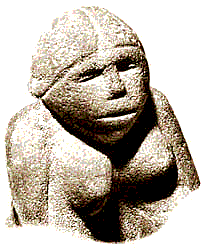 The
MISSISSIPPI and OHIO BASIN
The
MISSISSIPPI and OHIO BASINAncient countries of the region between southern Appalachia and Arkansas: mound temples, inscribed tablets, sculpture, sacred pipes, shell ornaments. Etowah, Adena, Cahokia. Female iconography in stone, shell, and ceramic. Clan mothers, housebuilders, weavers, chieftains, and herbalists. Nanyehi and the Cherokee office of Ghigau. Invasion, colonization, forced migration and genocide. Resistance and resurgences.
Miami, Ottawa, Mesquakie, Peoria, Kickapoo, Potawatomie, Hochunk, Menominee, and Ojibwa nations. [under construction]
We want an independent sovereign Oglala Sioux nation. We don't want no part of the government, Tribal or BIA... We want our old 1868 Treaty back." --Gladys Bissonette, Wounded Knee, 1973
North America from Saskatchewan to Chihuahua. Female leaders, clan mothers, warriors, elders of the Lakota, Blackfeet, Blood, Cheyenne, Arapaho, Kiowa and Pawnee. The matrilineal Wichita. Thatched houses, earth lodges and tipis. Women's arts: baskets, quillwork, beads, painting, and appliqué; building tipis and thatched houses. Medicine women from Montana to Texas. Wounded Knee and the American Indian movement.
The first Pend d'Oreille to dash out at the enemy was a woman named Kuilix, 'the Red One'... renowned for intrepidity on the field of battle.
--Nicholas Point, circa 1846Alaska, the Pacific coast to Oregon and Idaho. Ancient Okvik, modern Yupik culture. Tlingit, Haida, Tsimshian matrilineages. Baskets, weaving, sculpture, lodges. Ancestral mothers Rhipusunt and Dzalarhons. Tsagaglalal, "She Who Watches" of the Wishram, and other legendary women of the Columbia river. Drummers, elders, land rights activists.
Long ago an old woman named Co'tsi'pama'pöt made the whole country... Co'tsi'pama'pot made deer, cottontail rabbits, bears, antelope and every kind of animal out of mud, threw them off and bade them take to the mountains. --Creation story from Moapa, southern Nevada
Female images in clay and stone in Utah. Rock murals of the Chumash. Mohave and Yuma art. Rebellions against the Spanish mission system, some led by women like Toypurina of the Tongva and the prophetess of Chupu among the Chumash. Acorn harvesters, basketmakers, and the mostly female "Indian doctors," such as the Eem of the Karok. Native responses to Anglo conquest, enslavement and genocide. Modern cultural renewal and sovereignty movements.
Long ago Thinking Woman finished everything, thoughts and the names of everything here on earth, and she also finished all the different languages. --Tradition of Laguna Pueblo
Ancient civilizations of Hohokam and Anasazi. The great pueblos of Oraibi, Acoma, Cochiti, Taos and more. Sacraments of the Corn Mother, Spider Grandmother. Women's ceramic art, adobe and stone architecture. Spanish and Anglo colonizations and resistance. Modern artists, writers, and activists.
DINÉ / NAVAJO / TINNEH / APACHE
Women weavers, basketmakers, and herders. The Diné (Navajo and Apache) womanhood initiations. A heritage of sacred chants, including the Blessing Way of Changing Woman. Lozen, the intrepid lesbian shaman who led the Apache in their flight from settler armies, one of the greatest warriors of her nation. The Long Walk of the Diné, force-marched to reservation lands in the 19th century.
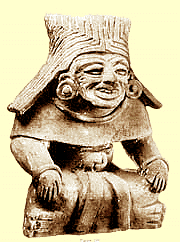 ANCIENT
MEXICO
ANCIENT
MEXICO
The rich and diverse images of Mexican women in sculpture and paint, including the ancient clay figurines of Tlatilco, las Bocas, and Chupícuaro. The pyramids, sculpture and murals of Teotihuacán, with their great Goddess, and the magnificent funerary urns of the Zapotec at Monte Albán in Oaxaca, as well as the lesser-known female figurines of Guerrero and Michoacán. The priestesses and dancers of Remojadas and El Tajin, the majestic stone statues of the Huastec, and the Cihuateteo shrines of Veracruz.
WESTERN MEXICO
Ancient ceramic sculpture of Jalisco, Colima, and Nayarit, with powerful, robust women. Casas Grandes: the pueblos of old northwest Mexico. The matrilineal Seri of the Sonoran desert, and the genocidal assaults they, like the Yaquis, faced in the 19th century. Teresa de Cabora, an Indian shaman-healer hailed as a saint and prophetess of the Indian liberation movement in the 1880s. The arts and ways of the Huichol and Ruramuri (Tarahumara).
THE AZTECS
"Our mother is as twelve eagles, goddess of drum-beating... She comes adorned in the ancient manner with the eagle crest,
in the ancient manner with the eagle crest." --Icuic (praise-song) of QuilaztliNorthern origins and Mesoamerican influences. Quilaztli, early sexual politics, and the Cihuacoatl. Ixlilxochitl, the priestesses, and other historical women. Aztec cosmology, with emphasis on the goddesses, including Coatlicue, Teteoinan, Xilonen and other Corn Mothers, Chalchiutlicue, and more. Tlazalteotl, birth mysteries, and the Cihuateteos. Sculptures, murals, codices and other masterpieces from Tenochtitlán, one of the world's greatest cities. The Toltecs, Mixtecs and Tarascans are in here too...
Silly men, you who accuse / women without excuse / Not seeing you're the cause / of what you blame them for...
What impulse could be stranger / than, outside all reason / to cloud the mirror yourself / then resent that it's not clear?
-- Sor Juana Inez de la Cruz, circa 1690The Spanish invasion, the fate of Malinal, and the birth of mestizo culture. Sor Juana de la Cruz, doña Josefa, Dolores Jimenez y Muro, la China Poblana. Mixtec cacicas. Women warriors for Tierra y Libertad. Huichol, Tehuanas, and other indigenous peoples in modern Mexico. Frida Kahlo, La Tigresa and other rebels, artistic, political and cultural.
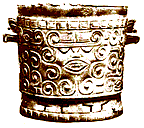 CENTRAL
AMERICA
CENTRAL
AMERICAWoman Mistress Mother in the heart of the sky: the child of Sea Woman, the child of She-in-the-Middle of-Cenote, the child of She Who Sits in the Mud, the child of She Who Emerges from the Sand.--Litany of the Bacabs, Yucatán
Olmecs and the rise of the Maya civilization. Female iconography in the ceramics, sculpture and codexes of Guatemala, Yucatán and Chiapas. Indigenous cultures of Honduras, El Salvador and Nicaragua. Archaeology of Costa Rica and Panama. The Cuna. Female torches of revolt: María Candelaria, Agustina Gomez Checheb, and the unnamed woman oracle in the cave-temple of Xucaneb. The genocide of the late 20th century in Guatemala. Women in modern democratic and indigenous sovereignty movements.
Everything sprang from Kuma, and everything the Yaruro do was arranged so by her;
the other gods and culture heroes act according to her laws. --Venezuelan traditionArawak and Carib peoples. Ceramic art of Venezuela and stone zemis of the Tainos. Loiza, Anacaona and female chiefs in the conquest period. Genocide, slavery, and uprisings. Breakaway communities of free Africans: the Maroons of Jamaica, the Saramaka of Surinam. African religions of the santeros and vodunsis. Inquisitors pursuit mohanes and curanderos (medicine people). Modern indigenous peoples.
I personally have had 1,104 sanctuaries, houses, and idols burned to date, and another 400 have been burned on my orders.
--Bishop Antonio de Alcegao to the king of Spain, 1607, on persecuting indigenous religion as "devil-worship."Ancient ceramics of Puerto Hormiga. The ceramic women of the great mound at Betancí. Gold of the Sinu river, the Tairona highlands, the Quimbaya and the Muisca. Monumental sculpture of San Agustín and murals of the Tierradentro culture. The Inquisition against indigenous and African religions. Policarpa Salvarrieta and other valiant women. Modern matrilineages and other indigenous cultures fighting for their land and cultural survival.
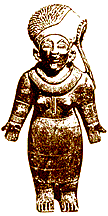
Female figurines from Valdivia in the 5th millennium. Masterpiece of ceramic art in the Chorrera, La Tolita and Jamacoaque cultures. Stone stelas of birthing mothers at Manabí and Cerro Jaboncillo. Inca rule, then the Spanish conquest. Black Ecuadorians, rainforest peoples, women's pottery and painting in a much-overlooked center of artistic achievement. Andean and Amazon basin people, and the fight for sovereignty and survival.
 PERU
PERUShe was a witch ... but helped the poor. -- Guaman Poma on the Coya, Mama Ocllo
Ceramics and weavings of ancient Paracas and Nazca. Chimu, Chavin, Paracas, Nazca; Mochicas, Quechuas and Aymaras. Priestesses, drummers, weavers and farmers of the central Andes. Architecture, pyramids, astronomy, and cosmology. Pachamama. Mama Huaca and the Coyas. Spanish conquest and Inquisition. Women in colonial and modern Peru.
Here were seen Indian women with bows and arrows who fought as vigorously, or more so, than the men... They acted as leaders, took the foremost place in the battle... --Carbajal, invading Brazil in 1542
Ancient ceramics of the Amazon river peoples. Marajó, Santarem, Tapajós. Women's work, arts, and ceremonial. The European invasion and plantation slavery. Tupi and Africans join forces in the Cabanagem revolt. The Quilombos (free African states). Calundureiras (Afro-Brazilian priestesses), the Inquisition, and the victory of African religions. Women in colonial Brazil. Indigenous nations' fight for survival and land rights. Women's rights in modern Brazil.
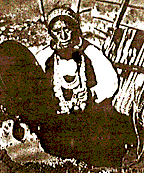 CHILE,
ARGENTINA, PARAGUAY
CHILE,
ARGENTINA, PARAGUAYArauco has a sorrow / Which I cannot silence / The injustices of centuries / That everyone sees inflicted / No one has remedied them / Though they could be remedied / Rise up, Huenchullán! -- Violeta Parra
The rich archaeology of northwest Argentina -- Condorhuasi, la Aguada, Candelaria -- and of Diaguita in Chile. The Mapuche and their machi (women shamans). Colonial Buenos Aires. Traditions of men taking over female rituals in Tierra del Fuego. Genocide in Argentina, Uruguay and Paraguay. The "disappeared" and las Madres de la Plaza de Mayo. The vision of Violeta Parra, Mercedes Sosa and Isabel Allende.